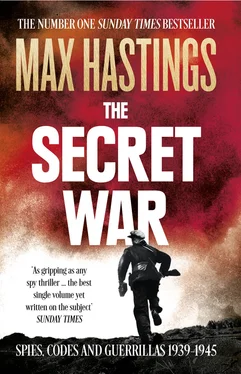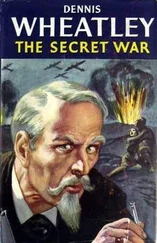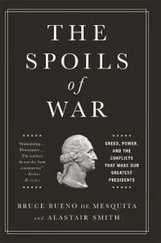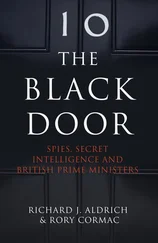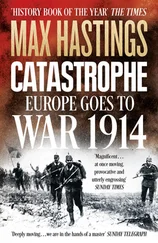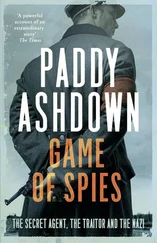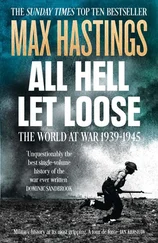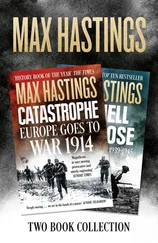Nobody knew, in the beginning, whether a given message hijacked from the airwaves might be an order from Hitler for his armies to march on Warsaw, or a request from a Luftwaffe airfield in eastern Germany for a delivery of filing cabinets. Ahead of the codebreakers lay a mammoth menu of requirements which could only be addressed as mobilisation sluggishly made available ears, brains and hands to monitor the enemy’s frequencies around the clock, log some of his vast output of messages, fix the locations and possible identities of the senders – diplomatic, police, military, naval or air force. Then came the much greater challenge, of discovering what the messages meant.
All radio communications involved a trade-off between speed and security. At the simplest level, battlefield direction by land, sea and air required some voice linkage. This enabled the instantaneous passage of orders and information, at the cost of being overheard by anybody else who cared to tune to a given frequency. Crude security could be introduced by using coded callsigns in place of names and suchlike – during the Battle of Britain fighter controllers added 5,000 feet to indicated altitudes, to confuse eavesdroppers. But voice messaging was inherently insecure: sensitive information should never be passed verbally, though it often was.
Most military messages were instead wirelessed by Morse key. Low-level material could be rapidly encrypted under battlefield conditions by relatively unsophisticated personnel using so-called hand- or field-ciphers, usually involving groups of two or three letters or numbers – the Kriegsmarine employed twenty-seven variants. More sensitive traffic, issuing from higher echelons, was translated by machine-generated or manual ciphers, usually involving combinations of four or five letters or numbers. The British thought justifiably highly of the security of their Type-X machines, though they never had enough of them. *The Americans rightly trusted their Sigaba, a fifteen-rotor system.
For substantial periods between 1939 and 1943 the Germans broke some Allied codes, including those of the US State Department and military attachés, along with the traffic of several exile governments, notably the Poles and Free French. They sometimes also accessed messages of all three British services, including the RAF’s four-character cipher, and later had successes in attacking products of the US Army’s M-209 field-ciphering machine. It deserves emphasis that Allied code-security weaknesses, and enemy achievements in exploiting them, gave the Germans much more operational assistance than some Western historians acknowledge, especially in the Battle of the Atlantic. However, higher British, American and Russian communications defied enemy scrutiny: Nazi eavesdropping on transatlantic telephone conversations between Churchill and Roosevelt told Berlin little of value. Modern claims that the Germans broke into Russian higher ciphers deserve to be treated with caution: certainly from 1942 onwards, there is no evidence that Hitler’s generals profited from any such insights; if they had, they would have been less often deluded by Soviet deceptions.
Most German senior officers – though by no means all their cryptographers – were confident that Enigma ciphering machines, which scrambled messages by means of shifting rotors and a plugboard, and rendered them comprehensible only by a matching machine with identical settings, were immune to the attention of any enemy, and indeed to the workings of the human brain. It is unsurprising that in 1939 they discounted the possibility that electro-mechanical technology might dramatically accelerate exposure of the Enigma’s secrets, because it did not then exist. It is extraordinary, however, that such serene confidence persisted through six years that followed, even following the discovery that the Poles had broken some pre-war Enigma traffic, and several warnings from their own experts. Amazing hubris was expressed by the Wehrmacht’s last signals chief, Lt. Gen. Albert Praun, who preened himself before his Allied captors after the war ended: ‘The achievements of German communications intelligence … may speak in favour of the German type of intelligence organisation.’ His organisation, he said, ‘gave German commanders a hitherto unattained degree of [signal] security’.
The British breaking of the Enigma, then subsequently and separately of German teleprinter traffic, was a progressive, incremental operation which attained maturity only between 1943 and 1945, and was never uninterrupted or comprehensive: even at peaks, only about half of all intercepts were read, many of them too late to provide practical assistance ‘at the sharp end’. What was done at Bletchley Park was indeed miraculous, but the codebreakers were never able to walk on all of the water, all of the time.
The 1939–40 Phoney War conferred few benefits on Britain, but it granted GC&CS precious time to bolster its strength and refine its methods. Without mechanical aids Bletchley’s brainstormers made modest and delayed breaches in a small number of enemy ciphers. The Germans employed acronyms and codenames which took weeks or months for their enemies to interpret. The importance of what happened at Bletchley in the first two years of war was not that it enabled Britain’s generals to avert or arrest a disastrous run of defeats, which it certainly did not, but that it lit a candle of hope about what the codebreakers and their embryo technology might accomplish in the future. It enabled the directors of the war effort to lay upon the board a few scattered pieces of a vast jigsaw, which would be filled only during the Allies’ years of victory.
Bletchley Park – Station X, Box 111 c/o The Foreign Office – was a notably ugly Victorian pile of bastard architectural origins surrounded by fifty-five acres of trees and grassland, located fifty miles from London. It was purchased in 1938 to house GC&CS at a safe distance from German bombs by Admiral Sir Hugh Sinclair, then head of MI6; as legend has it, he used £7,500 out of his own pocket, but more plausibly he paid with secret funds under his control. Whatever MI6’s humint weaknesses, the service’s chiefs, especially Sinclair, deserve full credit for backing the establishment of Bletchley at a time when resources were desperately constrained. Work began at once on laying direct phone and teleprinter lines to London, and in the following year MI6’s skeleton team of cryptanalysts moved from Broadway to the Park, where they came under the orders of Alastair Denniston. One of his colleagues from the old Admiralty days, Dillwyn Knox, an expert on ancient Egyptian papyri, became an early Bletchley stalwart. The most prominent of the younger recruits were Gordon Welchman of Sidney Sussex College, Cambridge, Hugh Alexander, Stuart Milner-Barry, John Jeffreys – and Alan Turing.
This last, the twenty-seven-year-old son of an Indian civil servant and the product of an austere and emotionally arid childhood, had just returned from a stint at Princeton clutching one of his own creations, a so-called electric multiplier machine mounted on a breadboard. His headmaster at Sherborne had once written: ‘If he is to stay at a public school, he must aim at becoming educated . If he is to be solely a Scientific Specialist , then he is wasting his time.’ In the headmaster’s terms, Turing had indeed been ‘wasting his time’: he had evolved into a shy, narrow, obsessive. Noel Annan wrote: ‘I liked his sly, secret humour … His inner life was more real to him than actuality. He disliked authority wherever he was … [and] enjoyed games and treasure hunts and silliness … Turing was the purest type of homosexual, longing for affection and love that lasted.’ More even than by his sexuality and his often childlike immaturity, however, his tragedy was to be afflicted by the exquisitely painful loneliness of genius.
Читать дальше
